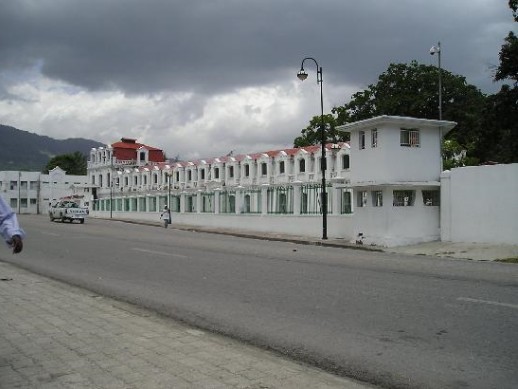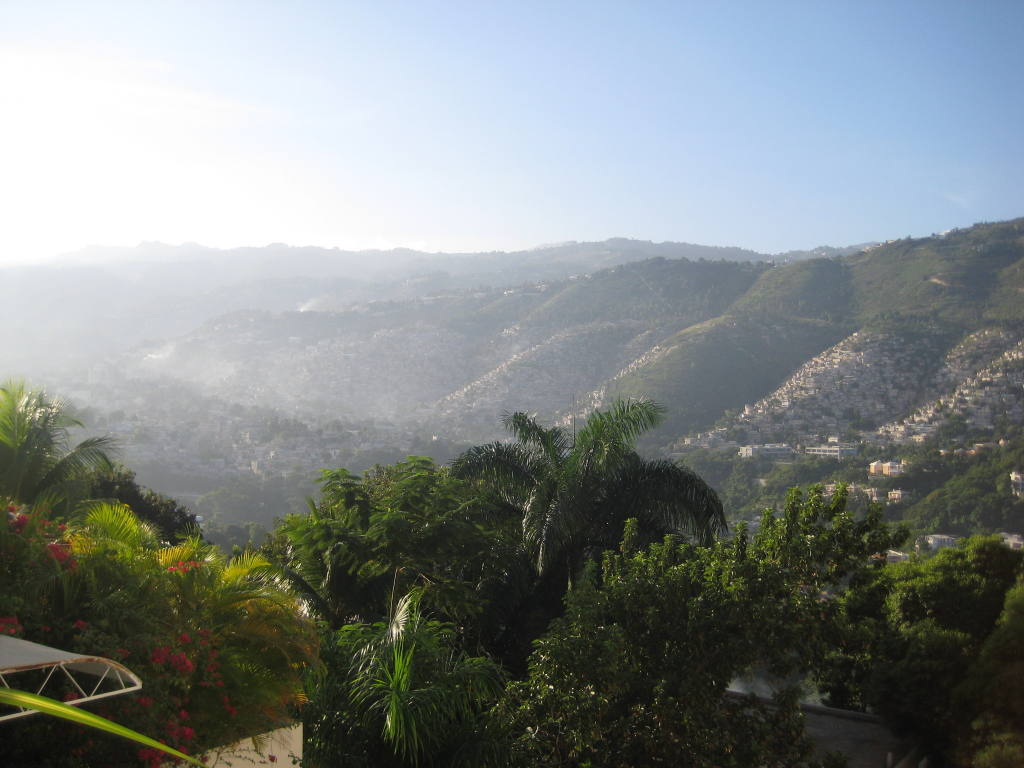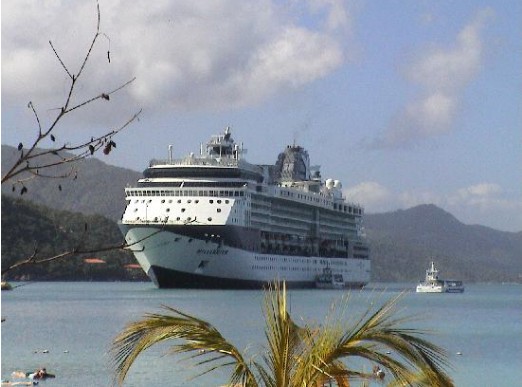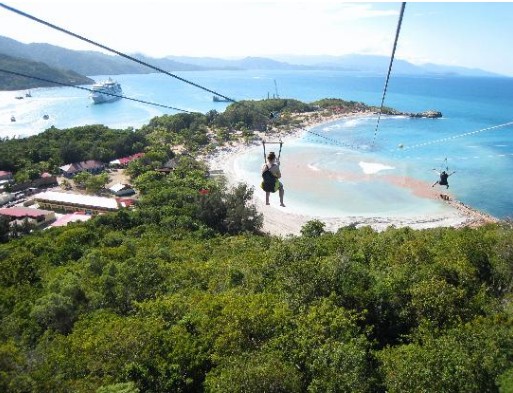The Caribbean Island Of Haiti
|

Haiti, Haitian Creole: Ayiti), officially the Republic of Haiti (République
d'Haïti ; Repiblik Ayiti), is a Creole- and French-speaking Caribbean country. Along with the
Dominican Republic, it occupies the island of Hispaniola, in the Greater Antillean archipelago.
Ayiti (Land on high) was the indigenous Taíno or Amerindian name for the mountainous western side
of the island. The country's highest point is Pic la Selle, at 2,680 metres (8,793 ft). The total
area of Haiti is 27,750 square kilometres (10,714 sq mi) and its capital is
Port-au-Prince.
Haiti's regional, historical, and ethnolinguistic position is unique for several reasons. It was
the first independent nation in Latin America, the first post-colonial independent black-led nation
in the world, and the only nation whose independence was gained as part of a successful slave
rebellion. Haiti is the only predominantly Francophone independent nation in the Americas, and one
of only two (along with Canada) which designate French as an official language; the other
French-speaking countries are all overseas départements or collectivités of France.
|
History
|
|
 The island of
Hispaniola, of which Haiti occupies the western third, was originally inhabited by the Taíno
Arawaks, a seafaring branch of the South American Arawaks. Christopher Columbus landed at Môle
Saint-Nicolas on 5 December 1492, and claimed the island for Spain. Nineteen days later, his
ship the Santa María ran aground near the present site of Cap-Haitien; Columbus was forced to
leave 39 men, founding the settlement of La Navidad. Ayiti, which means "mountainous land", is
a name used by the Taíno-Arawak people, who also called some sections of it Bohio, meaning
"rich villages". Kiskeya is yet a third term that has been attributed to the Taínos for the
island. The island of
Hispaniola, of which Haiti occupies the western third, was originally inhabited by the Taíno
Arawaks, a seafaring branch of the South American Arawaks. Christopher Columbus landed at Môle
Saint-Nicolas on 5 December 1492, and claimed the island for Spain. Nineteen days later, his
ship the Santa María ran aground near the present site of Cap-Haitien; Columbus was forced to
leave 39 men, founding the settlement of La Navidad. Ayiti, which means "mountainous land", is
a name used by the Taíno-Arawak people, who also called some sections of it Bohio, meaning
"rich villages". Kiskeya is yet a third term that has been attributed to the Taínos for the
island.
The Taíno population on Hispaniola was divided through a system of established cacicazgos
(chiefdoms), named Marien, Maguana, Higuey, Magua and Xaragua, which could be further subdivided.
The cacicazgos (later called caciques in French) were tributary kingdoms, with payment consisting
of food grown by the Taíno. Taino cultural artifacts include cave paintings in several locations in
the nation, which have become national symbols of Haiti and tourist attractions. Modern-day
Léogane, a town in the southwest, is at the epicenter of what was the chiefdom of
Xaragua.
|
|
Following the destruction of La Navidad by the Amerindians, Columbus moved to the eastern side
of the island and established La Isabela. One of the earliest leaders to fight off Spanish conquest
was Queen Anacaona, a Taíno princess from Xaragua who married Chief Caonabo, a Taíno king (cacique)
from Maguana. The two resisted European rule but to no avail; she was captured by the Spanish and
executed in front of her people. To this day, Anacaona is revered in Haiti as one of the country's
first founders, preceding the likes of founding fathers such as Toussaint Louverture and
Jean-Jacques Dessalines.
The Spaniards exploited the island for its gold, mined chiefly by local Amerindians directed by
the Spanish occupiers. Those refusing to work in the mines were slaughtered or forced into slavery.
Europeans brought chronic infectious diseases with them that were new to the Caribbean. Diseases
were the most powerful of the elements because the Taíno had no natural immunity, but ill
treatment, malnutrition and a drastic drop of the birthrate also contributed to decimation of the
indigenous population.
The Spanish governors began importing enslaved Africans for labor. In 1517, Charles V,
authorized the draft of slaves. The Taínos became virtually extinct on the island of Hispaniola.
Some who evaded capture fled to the mountains and established independent settlements. These
survivors mixed with escaped African slaves (runaways called maroons) and produced a multiracial
generation called zambos. French settlers later called people of mixed African and Amerindian
ancestry marabou. The mestizo increased in number from children born to relationships between
native women and European men. Others were born as a result of unions between African women and
European men, who were called mulâtre in French.
The western part of Hispaniola soon was settled by French buccaneers. Among them, Bertrand
D'Ogeron succeeded in growing tobacco, which prompted many of the numerous buccaneers and
freebooters to turn into settlers. This population did not submit to Spanish royal authority until
the year 1660 and caused a number of conflicts.
Independence
The French government changed and the
legislature began to rethink its decisions on slavery in the colonies. After Toussaint L'Ouverture
created a separatist constitution, Napoleon Bonaparte sent an expedition of 30,000 men under the
command of his brother-in-law, General Charles Leclerc, to retake the island. Leclerc's mission was
to oust Louverture and restore slavery. The French achieved some victories. Leclerc invited
Toussaint Louverture to a parley, kidnapped him and sent him to France, where he was imprisoned at
Fort de Joux. He died there in 1803 of exposure and tuberculosis or malnutrition and pneumonia.
The native leader Jean-Jacques Dessalines, long an ally of Toussaint Louverture, defeated the
French troops led by Donatien-Marie-Joseph de Vimeur, vicomte de Rochambeau at the Battle of
Vertières. At the end of the double battle for emancipation and independence, former slaves
proclaimed the independence of Saint-Domingue on 1 January 1804, declaring the new nation as Haiti,
honoring one of the indigenous Taíno names for the island. It is the only nation born of a slave
revolt
Dessalines was proclaimed Emperor for life by his troops. He exiled the remaining whites and
ruled as a despot. He was assassinated on 17 October 1806. The country was divided then between a
kingdom in the north directed by Henri Christophe, and a republic in the south directed by a gens
de couleur Alexandre Pétion. Henri Christophe is best known for constructing the Citadelle
Laferriere, the largest fortress in the Western Hemisphere, to defend the island against the
French. President Jean Pierre Boyer, also a gens de couleur, managed to reunify the two halves and
extend control again over the western part of the island.
In July 1825, the king of France Charles X sent a fleet of fourteen vessels and troops to
reconquer the island. To maintain independence, President Boyer agreed to a treaty by which France
recognized the independence of the country in exchange for a payment of 150 million francs (the sum
was reduced in 1838 to 90 million francs) - an indemnity for profits lost from the slave trade. The
French abolitionist Victor Schoelcher wrote ‘Imposing an indemnity on the victorious slaves was
equivalent to making them pay with money that which they had already paid with their blood.'
A long succession of coups followed the departure of Jean-Pierre Boyer. National authority was
disputed by factions of the army, the elite class and the growing commercial class, now made up of
numerous immigrants: Germans, Americans, French and English.
|
Geography
|
|

Haiti is situated on the western part of Hispaniola, the
second largest island in the Greater Antilles. Haiti is the third largest country in the
Caribbean behind Cuba and the Dominican Republic (the latter shares a 360 kilometer (224 mi)
border with Haiti). Haiti at its closest point is only about 45 nautical miles (50 mi; 80 km)
away from Cuba and boasts the second longest coastline (1,771 km/1,100 mi) of any country in
the Antilles, Cuba having the longest. Haiti's terrain consists mainly of rugged mountains
interspersed with small coastal plains and river valleys.
The northern region consists of the Massif du Nord (Northern Massif) and the Plaine du Nord
(Northern Plain). The Massif du Nord is an extension of the Cordillera Central in the Dominican
Republic. It begins at Haiti's eastern border, north of the Guayamouc River, and extends to the
northwest through the northern peninsula. The lowlands of the Plaine du Nord lie along the northern
border with the Dominican Republic, between the Massif du Nord and the North Atlantic Ocean. The
central region consists of two plains and two sets of mountain ranges. The Plateau Central (Central
Plateau) extends along both sides of the Guayamouc River, south of the Massif du Nord. It runs from
the southeast to the northwest. To the southwest of the Plateau Central are the Montagnes Noires,
whose most northwestern part merges with the Massif du Nord.
The southern region consists of the Plaine du Cul-de-Sac (the southeast) and the mountainous
southern peninsula (also known as the Tiburon Peninsula). The Plaine du Cul-de-Sac is a natural
depression which harbors the country's saline lakes, such as Trou Caïman and Haiti's largest lake
Lac Azuei. The Chaîne de la Selle mountain range, an extension of the southern mountain chain of
the Dominican Republic (the Sierra de Baoruco), extends from the Massif de la Selle in the east to
the Massif de la Hotte in the west. This mountain range harbors Pic la Selle, the highest point in
Haiti at 2,680 metres (8,793 ft).
The country's most important valley in terms of crops is the Plaine de l'Artibonite, which is
oriented south of the Montagnes Noires. This region supports the country's (also Hispaniola's)
longest river, the Riviere l'Artibonite which begins in the western region of the Dominican
Republic and continues most of its length through central Haiti and onward where it empties into
the Golfe de la Gonâve. The eastern and central region of the island is a large elevated plateau.
Haiti also includes various offshore islands. The historically famous island of Tortuga (Île de la
Tortue) is located off the coast of northern Haiti. The arrondissement of La Gonâve is located on
the island of the same name, in the Golfe de la Gonâve. Gonave Island is moderately populated by
rural villagers. Île à Vache (Island of Cows) is located off the tip of southwestern Haiti. It is a
lush island with many beautiful sights. Also part of Haiti are the Cayemites and Ile de
Anacaona.
|
| Back to the Top
| Return Home| |
Economy
|
|

Haiti has remained the least-developed country in the Americas. It is an impoverished country,
one of the world's poorest and least developed. Comparative social and economic indicators show
Haiti falling behind other low-income developing countries (particularly in the hemisphere) since
the 1980s. Haiti now ranks 146th of 177 countries in the United Nations Human Development Index
(2006). About 80% of the population were estimated to be living in poverty in 2003. Haiti is the
only country in the Americas on the United Nations list of Least Developed Countries. Economic
growth was negative in 2001 and 2002, and flat in 2003.
About 66% of all Haitians work in the agricultural sector, which consists mainly of small-scale
subsistence farming, but this activity makes up only 30% of the GDP. The country has experienced
little formal job creation over the past decade, although the informal economy is growing. Mangoes
and coffee are two of Haiti's most important exports. It has consistently ranked among the most
corrupt countries in the world on the Corruption Perceptions Index.
Foreign aid makes up approximately 30%-40% of the national government's budget. The largest
donor is the United States followed by Canada, and the European Union also contributes. Venezuela
and Cuba also make various contributions to Haiti's economy, especially after alliances were
renewed in 2006 and 2007.
U.S. aid to the Haitian government was completely cut off in 2001-2004 after the 2000 election
was disputed and President Aristide was accused of various misdeeds. After Aristide's departure in
2004, aid was restored, and the Brazilian army led the United Nations Stabilization Mission in
Haiti peacekeeping operation.
Haiti is expected to receive debt forgiveness for about $525 million of its debt through the
Heavily Indebted Poor Countries (HIPC) initiative by mid-2009.
Languages
One of Haiti's two official languages is French, which is the principal written, spoken in schools
and administratively authorized language. It is spoken by most educated Haitians and used in the
business sector. The second is the recently standardized Haitian Creole,[20] spoken by virtually
the entire population of Haiti. Nearly all Haitians speak this French-based creole language that
harbors significant African influence, as well as influence from Spanish, and Taíno. Residents near
the border with the Dominican Republic have often learned enough Spanish for conversational
speaking. Due to its ties to the United States, English has also become an important tool in the
business sector.
Culture
Haiti has a long and storied history and therefore retains a very rich culture. Haitian culture is
a mixture of primarily French, African elements, and native Taíno, with some lesser influence from
the colonial Spanish. The country's customs essentially are a blend of cultural beliefs that
derived from the various ethnic groups that inhabited the island of Hispaniola. In nearly all
aspects of modern Haitian society however, the European and African element dominate. Haiti is
world famous for its distinctive art, notably painting and sculpture.
|
Flag of Haiti
|
|

The flag of Haiti was adopted on February 25, 1987. The flag is divided into two rectangles
going across horizontally. The top half is blue and the bottom is red. Since 1843 the flag for
official and state use has had the coat of arms of Haiti on a white panel in the center. The coat
of arms depicts a trophy of weapons ready to defend freedom, and a royal palm for independence. The
palm is topped by the Cap of Liberty. The national motto is on a white scroll reading L'Union Fait
La Force ("Unity Makes Strength"). The civil flag and ensign lacks the emblem.
The blue and red of the flag were retained after a French Tricolore was torn up by the
revolutionary Jean-Jacques Dessalines in 1803. The two parts were stitched together horizontally to
make a new flag.
At the 1936 Summer Olympics in Berlin, it was found that Haiti and Liechtenstein were using the
same flag, which led to a crown being added to the flag of Liechtenstein.
A rival flag of vertical black and red panels was used at various times, most recently in the
period from May 25, 1964 to February 25, 1986, during the family dictatorship of François and
Jean-Claude Duvalier.
|
|

Getting married in Haiti
Getting married in the Caribbean Island of Haiti is very easy and simple for you to have the
wedding of your dreams.
Requirements:
1. Notarized copies of Divorced Decree if divorced or Notarized copies of Death Certificates.
2. Birth certificate of each party that is getting married.
3. A blood test is required
|
Haiti Things to Do
|
|

The Island of Haiti is full with
lots of activities for you to do on your Vacation
the numerous of activities will sure to keep you busy during your vacations to this country.
The most common activities will be sightseeing; next you can take a visit the mountains, parks,
lakes, valleys and beaches founding Haiti.
The Island is known for its varied natural beauty and picturesque landscapes which are a real treat
for the eyes. apart from these, you can pay a visit to the numerous historical sights of the
country to get an idea about the country's history and turbulent past.
Tourists can go for numerous land and outdoor activities and water based activities when on a
holiday in Haiti. Some of the popular water sports that one can go for include snorkeling, scuba
diving, swimming, sailing, yachting and surfing, the tourist can play beach volleyball or simply
sun bathe under the shades of the palm trees.
There are numerous adventure sports also that one can go for. You can go for trekking, hiking,
rock climbing, forest exploration, zipline, camping and other activities. All these activities will
surely make your vacations a thrilling experience.
Food is an important itinerary of any vacation and hence forms part of the numerous Haiti things
to do. There are a large number of restaurants and cafes, like Café Cubano, where one can get to
taste mouth-watering gourmet delights and exotic drinks. Tourist can also pay a visit to the bars
and casinos of the country. Haiti is home to a number of casinos like Casino El rancho and Casino
Choucoune, where the tourist can try there luck at the slot machine or play roulette.
Shopping is another major activity that one can embark upon in Haiti. Petionville in
Port-au-Prince is a major shopping destination of the country. One can buy gift items, souvenirs,
handicrafts and other items from these shops. Cultural tours are another recreation option
available at the disposal of the tourists. One can check out the museums and cultural institutions
of the country to get a taste of its rich culture. You can also interact with the local people and
learn about their traditions and customs. Apart from these, one can also go for boating in then
lakes found in Haiti or check out the wildlife in the forest reserves of the country.
|
|